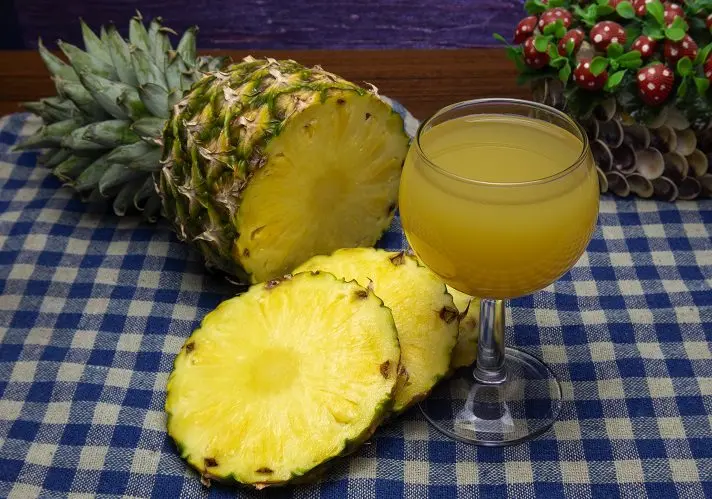Homemade pineapple wine is a light yellow dessert drink, slightly tart with a characteristic aroma and taste of pineapple. Due to the high cost of raw materials in our area, this is a rare, exotic spirit, but enthusiastic winemakers do not miss the opportunity to make pineapple wine if they find fruits at an affordable price, for example, immediately after the New Year holidays and Christmas, sellers are ready to sell the remaining pineapples at a good discount so that they have not deteriorated.
Theoretically, not only fresh, but canned and even dried pineapples are suitable for winemaking (pre-fill the pulp with hot water and leave for several hours), but these drinks will be significantly inferior in terms of aroma and taste to wine from fresh pineapple juice.
First, the pulp must be sorted out, removing spoiled, rotten and moldy parts. Even the smallest amount of bad raw materials can spoil the entire batch of the drink. In order not to infect the wort with fungus and pathogenic bacteria, all containers used should be sterilized with boiling water, then wiped dry with a clean cloth.
Ingredients:
- pineapple pulp – 2 kg;
- water – 2,5 liters;
- sugar – 200-250 grams per 1 liter of juice;
- citric acid – 2 grams per 1 liter of juice;
- wine yeast or sourdough – according to the instructions, 2-3% of the must volume.
I recommend using store-bought wine yeast for white and sparkling wines, in case of their absence, 3-5 days before working with raw materials, you need to make a starter from raisins or fresh berries. If you add ordinary baker’s yeast, you get mash instead of wine.
It is advisable to replace concentrated citric acid with freshly squeezed lemon juice – one medium-sized fruit contains 5-6 grams of acid.
pineapple wine recipe
1. Grind the peeled pineapple pulp with a meat grinder or blender. Put the resulting liquid into a plastic or enameled container with a wide neck – a bucket or pan.
2. Add all the water and 250 grams of sugar (10% of the volume of water in case of other proportions). Add sourdough or wine yeast. Mix until smooth.
3. Bandage the neck of the container with gauze so that insects do not get in. Transfer the must for 3 days to a dark room with a temperature of 18-28 °C. To prevent the wine from acidifying, stir the must every 8-10 hours with a clean wooden stick or hand, drowning the pulp in the juice – particles of pulp that have floated to the surface. After 4-12 hours from the moment the starter was introduced, signs of fermentation should appear: foam, hissing and a characteristic smell. This means that everything is going well.
4. Strain the wort through cheesecloth, folded in 2-3 layers. Press the cake to dryness (no longer needed).
5. Add filtered juice, citric acid and sugar at the rate of 100 grams per liter minus the sugar added earlier. For example, if you get 3 liters of juice, then you need to add another 50 grams (300 – 250 = 50).
6. Pour the future pineapple wine into a fermentation tank, filling a maximum of 75% of the volume so that there is room for foam and carbon dioxide.
7. Install any water seal. You can use a clean medical glove with a hole in one of the fingers. Move the container to a dark place with a stable temperature of +20-28 °C. Leave until the end of fermentation.

8. After 4-5 days, add the next portion of sugar – 50 grams per 1 liter of juice. To do this, remove the water seal, pour 150-200 ml of wort into a separate container, dilute sugar in it, then pour the resulting syrup back into the fermentation tank and close it with a water seal.
9. After another 5 days, repeat the procedure, adding another portion of sugar – 50 g / l according to the scheme described in the previous stage.
10. Depending on the strain of yeast and temperature, the fermentation of homemade pineapple wine lasts 35-60 days. The end of the process is indicated by the absence of bubbles from the water seal (deflated glove), the appearance of a layer of loose sediment at the bottom and a significant clarification of the wort.
Attention! If fermentation does not stop after 50 days from the date of installation of the water lock, so that bitterness does not appear, you need to drain the wine from the sediment into another container and leave it to ferment at the same temperature.
Pour the young fermented wine into another container through a straw, trying not to touch the sediment at the bottom.
11. Taste the drink, optionally sweeten with sugar (up to 50 g/l). You can also increase the strength with alcohol or vodka in an amount of 2-15% of the volume. Fortified wine keeps better, but has a tougher taste.
12. Pour the drink into holding containers. It is advisable to fill up to the very neck to minimize contact with oxygen. Close hermetically, transfer to maturation in a cellar, cellar or refrigerator with a temperature of +2-16 °C. If sugar was added at the previous stage, it is better to keep the first 7-10 days under a water seal in case of repeated fermentation.
13. Aged pineapple wine for at least 4-6 months (preferably 7-9) to improve the taste. When a precipitate appears with a layer of 2-4 cm, filter, pouring through a tube into another container.
14. If the precipitate does not appear for a couple of months, the finished drink can be bottled for storage.
Shelf life – up to 3 years. Fortress – 9-13%.










